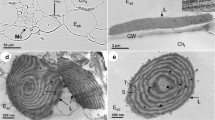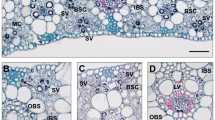Abstract
The ultrastructural aspects ofCyperus iria leaves showing the C4 syndrome and the typical C3 species,Carex siderosticta, in the Cyperaceae family were examined.C. iria exhibited the chlorocyperoid type, showing an unusual Kranz structure with vascular bundles completely surrounded by two bundle sheaths. The cellular components of the inner Kranz bundle sheath cells were similar to those found in the NADP-ME C4 subtype, having centrifugally arranged chloroplasts with greatly reduced grana and numerous starch grains. Their chloroplasts contained convoluted thyla-koids and a weakly-developed peripheral reticulum, although it was extensive mostly in mesophyll cell chloroplasts. The outer mestome bundle sheath layer was sclerenchymatous and generally devoid of organelles, but had unevenly thickened walls. Suberized lamellae were present on its cell walls, and they became polylamellate when traversed by plasmodesmata. Mesophyll cell chloroplasts showed well-stacked grana with small starch grains. InC. siderosticta, vascular bundles were surrounded by the inner mestome sheath and the outer parenchymatous bundle sheath with intercellular spaces. The mestome sheath cells degraded in their early development and remained in a collapsed state, although the suberized lamellae retained polylamellate features. Plastids with a crystalline structure, sometimes membrane-bounded, were found in the epidermal cells. The close interveinal distance was 35–50 μm inC. iria, whereas it was 157–218 μm inC. siderosticta. These ultrastructural characteristics were discussed in relation to their photosynthetic functions.
Similar content being viewed by others
Literature Cited
Brown WV (1975) Variations in anatomy, associations, and origins of Kranz tissue. Amer j Bot 62: 395–402
Brown WV (1977) The Kranz syndrome and its subtypes in grass systematics. Mem Torr Bot Club 23: 1–97
Bruhl J, Perry S (1995) Photosynthetic pathway-related ultrastructure of C3, C4 and C3-Iike and C3-C4 interme-diate sedges (Cyperaceae), with special reference toEleocharis. Aust J Plant Physiol 22: 521–530
Carolin RC, Jacobs SWL, Vesk M (1977) The ultrastructure of cells of the mesophyll and parenchymatous bundle sheath of the Gramineae. Bot J Linn Soc 66: 259–275
Chen TM, Dittrich P, Campbell WH, Black CC (1974) Metabolisms of epidermal tissues, mesophyll cells, and bundle sheath strands resolved from mature nutsedge leaves. Arch Bioch Bioph 163: 246–262
Dengler NG, Nelson T (1999) Leaf structure and development in C4 plants,In RF Sage, RK Monson, eds, C4 Plant Biology, Academic Press, New York, pp 133–172
Ehleringer JR, Monson RK (1993) Evolutionary and ecological aspects of photosynthetic pathway variation. Annu Rev Ecol Syst 24:411–439
Furbank RT, Taylor WC (1995) Regulation of photosynthesis in C3 and C4 plants: a molecular approach. Plant Cell 7: 797–807
Hatch MD (1987) C4 photosynthesis: a unique blend of modified biochemistry, anatomy and ultrastructure. Bioch et Biophys Acta 895: 81–106
Hattersley PW, Browning AJ (1981) Occurrence of the suberized lamella in leaves of grasses of different photosynthetic types. I. In parenchymatous bundle sheaths and PCR (“Kranz”) sheaths. Protoplasma 109: 371–401
Jones MB, Hannon GE, Coffey MD (1981) C4 photosynthesis inCyperus longus L., a species occurring in temperate climates. Plant Cell and Environment 4: 161–168
Kim IS, Pak JH, Seo BB, Song SD (1997) Ultrastructural aspects of Kranz anatomy inDigitaria sanguinalis andSetaria viridis (Poaceae). J Plant Biol 40: 102–109
Kim IS, Pak JH, Seo BB, Song SD (1998) Ultrastructural aspects of leaves inFestuca ovina andPoa sphondylodes (C3 Poaceae). J Plant Biol 41: 170–177
Laetsch WM (1971) Chloroplast structural relationships in leaves of C4 plants,In MD Hatch, CB Osmond, RO Slayter, eds, Photosynthesis and Photorespiration, Wiley Interscience, New York, pp 323–349
Laetsch WM (1974) The C4 syndrome: a structural analysis. Ann Rev Plant Physiol 25: 27–52
Li M, Jones MB (1994) Kranzkette, a unique C4 anatomy occurring inCyperus japonicus leaves. Photosynthetica 30: 117–131
Nelson T, Langdale JA (1992) Developmental genetics of C4 photosynthesis. Annu Rev Plant Physiol Plant Mol Biol 43: 25–47
Oh YC (1994) Manual of the Korean Cyperaceae. Vol II. Sungshin Womans University Press, Seoul, pp 23–59
Rao AP, Rajendrudu G (1989) Net photosynthetic rate in relation to leaf anatomical charateristics of C3, C3-C4 and C4 dicotyledons. Proc Indian Acad Sci 99: 529–537
Sage RF, Monson RK (1999) C4 Plant Biology. Academic Press, New York, pp 3–596
Soros CL, Dengler NG (1998) Quantitative leaf anatomy of C3 and C4 Cyperaceae and comparisons with the Poaceae. Int J Plant Sci 159: 480–491
Standley LA (1990) Anatomical aspects of the taxonomy of sedges (Carex, Cyperaceae). Can J Bot 24: 1449–1456
Takeda T, Ueno O, Agata W (1980) The occurrence of C4 species in the genusRhynchospora and its significance in Kranz anatomy of the Cyperaceae. Bot Mag 93: 55–65
Takeda T, Ueno O, Samejima M, Ohtani T (1985) An investigation for the occurrence of C4 photosynthesis in the Cyperaceae from Australia. Bot Mag 98: 393–411
Ueno O (1996) Structural characterization of photosynthetic cells in an amphibious sedge,Eleocharis vivipara, in relation to C3 and C4 metabolism. Planta 199: 382–393
Ueno O, Samejima M (1989) Structural features of NAD-malic enzyme type C4 Eleocharis: an additional report of C4 acid decarboxylation types of the Cyperaceae. Bot Mag 102: 393–402
Ueno O, Samejima M, Koyama T (1989) Distribution and evolution of C4 syndrome inEleocharis, a sedge group inhabiting wet and aquatic environments, based on culm anatomy and carbon isotope ratios. Ann Bot 64: 425–438
Ueno O, Takeda T (1992) Photosynthetic pathways, ecological characteristics, and the geographical distribution of the Cyperaceae in Japan. Oecologia 89: 195–203
Ueno O, Takeda T, Murata T (1986) C4 acid decarboxyl-ating enzyme activities of C4 species possessing different Kranz anatomical types in the Cyperaceae. Photosynthetica 20: 111–116
Ueno O, Takeda T, Maeda E (1988) Leaf ultrastructure of C4 species possessing different Kranz anatomical types in the Cyperaceae. Bot Mag 101: 141–152
Waterway M (1990) Systematic implications of achene micromorphology inCarex sectionHymenochlaenae (Cyperaceae). Can J Bot 68: 630–639
Author information
Authors and Affiliations
Corresponding author
Rights and permissions
About this article
Cite this article
Kim, I.S., Pak, JH., Seo, BB. et al. Ultrastructure of leaves in C4 Cyperus iria and C3 Carex siderosticta . J. Plant Biol. 42, 213–221 (1999). https://doi.org/10.1007/BF03030481
Received:
Accepted:
Issue Date:
DOI: https://doi.org/10.1007/BF03030481




